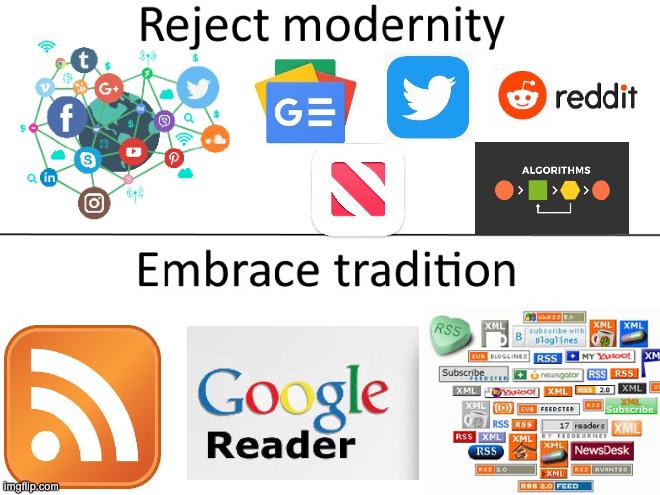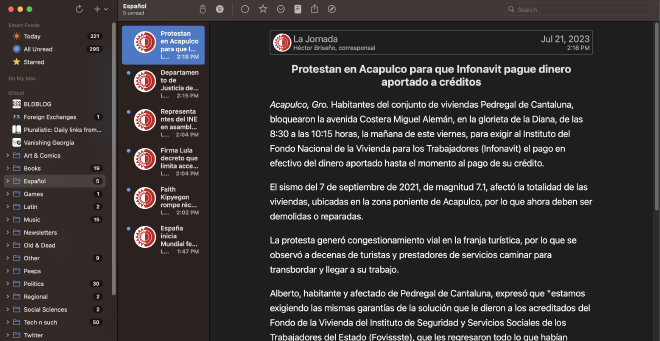Return to RSS

I love running this site with Hugo, but my one major gripe is how unintuitive it is to add an RSS feed to a personal site. Even if you add in the right shortcodes and partials, there’s no simple option to make it displayable on every page. I managed to get something working, but it’s far from ideal and the feed doesn’t show up well in my reader, so it’s definitely a work in progress.
Getting a good RSS feed working on my personal website is important for me, and not just because I was a devotee of Google Reader back in the day. A surprisingly large number of sites still offer RSS feeds, so it makes me wonder why very few of them advertise that fact. Why should a website be so ashamed to offer one of the most useful features the internet ever devised?
The Strangulation of Google Reader #
My personal conspiracy theory about the death (read: murder) of Google Reader has to do with the push from big tech companies towards algorithmically generated feeds. Instead of Twitter or Facebook showing you posts in reverse chronological order, it started guessing what you’d like to see and pushing those ahead of everything else. This has been the standard operating proceedure for social media sites for the past ten years, so it’s hard to imagine anything else now, but this wasn’t a given or natural historical progression. One thing standing in the way of big tech’s complete domination of content was this nifty open-source standard that would just send you updates directly, no middleman needed.
I suspect that Reader was killed off by Google because the decision makers considered it a threat to Google Plus. I find this funny not just because Plus eventually flopped and Reader is often looked back on as one the best products it ever offered, but because I remember thinking at the time that Plus would prevail over other social media sites specifically because it was integrated so well into Reader. This article from The Verge stated it perfectly: “In [Google’s] effort to build a splashy new social platform, the Reader team felt Google was missing the burgeoning one right under its nose.”
The Promise and the Problems of Algorithms #
Don’t get me wrong: there’s nothing per se wrong with regulating and modulating feeds with algorithms. There are so many cool things I wouldn’t have discovered without an algorithm presenting it to me. However, the way social media has used algorithmic feeds over the past decade violates what I would consider the closest thing to a universal rule about computers:
Probably the only “classic” social media site that still adheres to this maxim is Tumblr. Until very recently, Tumblr’s user feed started with the most recent stuff on top followed by everything else in reverse chronological order (you can return to this by deselecting “Best Stuff First” in the Dashboard settings). Once every five to ten posts, the feed will suggest some new blogs to follow or a post you might like, and it’s your choice to either engage or move on.
Apparently every other social media platform thinks I’m a silly child who can’t be trusted. I stopped regularly using social media over the past several years because, more often than not, I felt like these platforms were dragging me around by the collar. The programmers with their precious algorithms felt like they knew better than me about what I wanted to see, and while that might be broadly true at the scale of large populations, the individual user experience was absolutely obnoxious. I constantly felt like I was missing important updates in favor of things I absolutely did not care about. The only way I could find out that a favorite author was releasing a new book or that a favorite band was touring was by explicitly navigating to their pages, usually after thinking to myself “Say, I haven’t heard about them in a while. What have they been up to?”
I’d like to make a special mention of Youtube here, which used to allow users to personally curate similar subscriptions together into groups. For example, I could check what had been recently uploaded by the technology channels I subscribe to by navigating to the Technology feed. For some vaguely stated reason, Youtube removed this immensely useful feature, meaning I either have to wade through the poorly designed and overflowing Subscriptions tab or (surprise, surprise!) rely on the unquestioned wisdom of Youtube’s 100% perfect algorithm to display what I wanted to see on my front page. Yes, I know you’re supposed to click the bell icon if you want regular updates from a specific channel, which is basically Youtube asking its users to fix the problem it created in the first place.
But even if the algorithm behaved better (TikTok definitely has something in their secret sauce), I’m still uncomfortable with having a computer spoonfeeding me content. Some people point to Substack and the resurgence of email newsletters as an alternative, but this irks me; blogging and RSS were designed almost specifically to circumvent the clumsiness of interacting with the world through email.
Obviously, I’m not going to change the way major tech conglomerates do business, and the current way of doing things works just fine for Meta’s bottom line. All I know is what makes for an awful online experience and what can make it more rewarding.
Resolution: Live Inside Your RSS Aggregator #
Simply put, I try to interact with the internet through my RSS aggregator to the greatest extent possible. Sure, I add blogs and news sites, but I’ve also added in several newsletters and hundreds of subscriptions from Youtube, Reddit, and (before the current API apocalypse) Twitter. A couple times a day, I go through my unread tab and star the things that I want to look at in more detail. My browser should serve only as a place to view the output of my RSS aggregator. In a perfect world, aggregators would be developed well enough that I don’t have to navigate away from them at all.
Since I’ve started doing this, my online life has improved at least tenfold. After years of drudgery on social media, I’ve finally regained the original promise of the internet. I never miss an update and I get to choose what I want to read further. Sometimes it feels like I’m being hit with a firehose of content, but I’ve given myself the latitude to blaze past anything that doesn’t strike my fancy and mark hundreds of articles as read at a time without once looking at more that the headlines.

Google Reader has been gone for a decade, but plenty of services have risen in their wake. Feedly has been quite successful, though paying for an RSS reader rubs me the wrong way personally. I’d probably go with Newsboat if syncing between devices wasn’t so important to me. I currently use NetNewsWire, which syncs between devices using iCloud (also, I just learned that it predated Google Reader by a couple years). When I eventually get a home server running, I’ll look into running Fresh RSS on it, which can sync to both NNW and Newsboat.
Back in the day, I would only recommend Google Reader to those who were “extremely online”. Nowadays, that’s basically everyone, including you. Take back control of your time and your feed. Just as importantly, if you’re a website developer, be sure to add a feed and display the RSS badge prominently. Fixing the internet won’t happen overnight, but more users adopting RSS would be a big definitive step in the right direction.